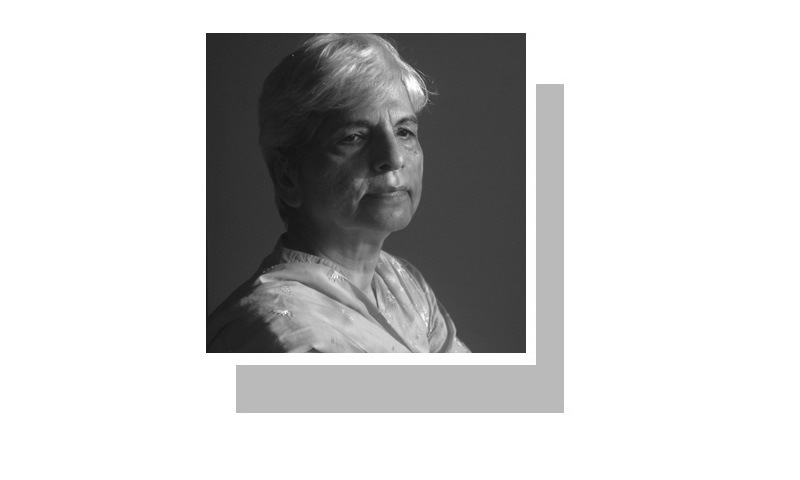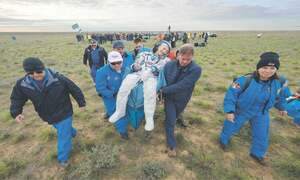
WHEN you start to despair — and we have too many occasions for that — go get the light of hope from someone who holds the candle. So I went to see Dr Ruth Pfau, who has been an inspiration for many, especially the most stigmatised of segments — her leprosy patients.
Even in her poor state of health in her hospital bed, Dr Pfau continues to be the candle of hope she has epitomised. She was hospitalised recently but is now in her own apartment in her neat and prim clinic. Of course, she is happy to be back home, she told me.
As I held her hand I could feel the “enrichment flow from her into me” to use her words. That is the role she has been playing since she arrived as a young woman of 31 in Karachi from Germany in 1960 and made Pakistan her home. It was chance that took her to the Lepers’ Colony behind the commercial offices on McLeod Road (now I.I. Chundrigar Road). The squalor and subhuman conditions did not deter her. Within three years, she had set up a proper leprosy clinic, now an eight-storey hospital on Shahrah-i-Liaquat, and the hub of 157 leprosy centres all over the country. There followed an arduous journey of over five decades devoted to “serving the unserved”. At no stage has her commitment slackened.
In her forthcoming autobiography, quoting an axiom, she writes, “It is better to light a candle than to curse the darkness” and, better still, “to keep it burning”.
Leprosy, according to Dr Pfau, ‘is not just a sickness’.
What I find striking about Dr Ruth Pfau is her holistic approach to the people she works for and whom she loves unconditionally.
Thus leprosy, the disease she focused on, is, according to her, “not just a sickness” with specific medical conditions, but also a monstrosity due to society’s attitude towards the person who is suffering from it. He or she is dubbed a sinner, a victim of the scourge of the divine.
It is this stigma that robs patients of their dignity and deprives them of their basic birthright that Dr Pfau finds disquieting. Hence in her scheme of things the cure is a process which not only treats the physical ailment but continues until the patient has been rehabilitated and has access to his right to food and clothing, shelter, education, health, equal job opportunities and, above all, social acceptance. With the risk of relapse ever present, leprosy workers have to establish lifelong associations with their patients who are monitored for early signs of any recurrence of the disease.
This sounds so idealistic in Pakistan’s context. But it has actually worked because Dr Pfau’s strategy from the initial years has been to focus on community development as well. She took healthcare to the patients right to their doorstep, personally visiting families to convince them that leprosy, a grossly misunderstood disease, was treatable.
After studying Dr Pfau’s approach, I feel that is the only one which can work in a Third World society. To be effective, a four-pronged strategy is needed: a) adopt preventive measures; b) educate communities to lower the incidence of diseases; c) provide curative treatment to those who still fall ill; d) monitor and detect early cases that recur to nip the damage in the bud.
Dr Pfau made an impact on the leprosy scene in Pakistan and in 1996; WHO declared that leprosy had been controlled in the country. Dr Pfau then set her sights on leprosy elimination, a bigger challenge as the incubation period can last from two to 40 years. In 2016, the number of patients under treatment in Pakistan were only 531 — a far cry from 19,398 in the early 1980s.
To use fully the capacity, it had created, the Marie Adelaide Leprosy Centre (MALC) branched out into tuberculosis and blindness prevention programmes in support of the government. Why TB? The TB bacterium is related to the leprosy bacillus. Why blindness? For the leprosy patient, blindness enhances his helplessness since he is robbed of his tactile ability as well. You need a lot of compassion to understand the feelings of those suffering from either of the two.
TB and blindness programmes require similar community efforts. With the socio-medical infrastructure in place for leprosy, the MALC could include these in its sphere of work.
Dr Ruth Pfau saw a rat nibbling the decayed foot of a leprosy patient who had lost sensation in his legs. That prompted her to “care for such patients” as she puts it.
What would you say about the case of a doctor in Umerkot who, reportedly, refused to touch a sanitary worker who was brought to the hospital in critical condition after inhaling gas in the gutter he was cleaning? The reason that was supposedly given was, “The man was covered with filth and I was fasting.”
Published in Dawn, June 9th, 2017









































